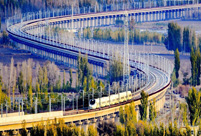

In the 2016 government work report delivered by Chinese Premier Li Keqiang Saturday, China's GDP growth target for 2016 was set in a range of between 6.5 and 7 percent, and the country's basic economic policy will be geared toward this.
Over the past two decades, the central government has been pursuing rapid growth, and this is the first time in 20 years that the annual growth target has been set below 7 percent, so it can be considered a significant move.
The target allows the government to shift away from solely pursuing GDP growth, and wholly alters the former idea of aiming for extensive but inefficient growth. This could fundamentally change the government's behavioral pattern and policy direction, paving the way for China to head for higher quality and improved efficiency in its growth, and also making room for bold reforms and economic restructuring.
Compared to the previous growth targets that were comparatively high and usually fixed to a specific figure, this year's goal is within a certain range, allowing more flexibility. If both the domestic and international economic situations are favorable, China's growth rate could reach 7 percent. But if the domestic and international environment is more challenging, it could drop to 6.5 percent. In either case, the government does not have to pursue growth for growth's sake.
The target range for 2016 allows the government to pursue significant economic reforms and restructuring. In the past, when high growth rates were pursued, the slash-and-burn approach to business operation and misuse of resources damaged the environment and natural resources, leaving piles of economic problems behind, including environmental degradation, imbalanced industrial structure, excessive capacity in certain industries, and over-dependence on the real estate sector. Addressing these issues is bound to influence GDP, but an obsession with rapid GDP growth could make these issues even worse.
The lower GDP target could also release some of the pressure from the problems that have accumulated over a long period. For instance, topics relating to dealing with overcapacity, allowing zombie enterprises to go bankrupt, improving the efficiency of resource usage, reducing pollution, and cutting over-dependence on real estate through industrial restructuring have all been reflected in this year's government work report.
The excessive pursuit of rapid economic growth and overreliance on the property industry in the past have distorted the market and certain government functions, leading to unreasonable income distribution, lower support for disadvantaged businesses and groups, slow reform in the financial market, and less-than-expected progress in implementing certain policies that could benefit the Chinese people.
Setting the growth target in a range of 6.5 to 7 percent can allow the government to increase the fiscal deficit and continue with structural tax cuts, thus making it possible to rectify these distortions. For example, the government can focus on investment in irrigation, development of shantytowns and dilapidated houses in urban and rural areas and building railways and roads in the country's central and western regions, as well as reducing the tax burden on firms to bolster the economy.
More importantly, the target will allow China's economic growth to be further driven by consumption and innovation, rather than depending heavily on traditional growth drivers like exports, investment and real estate, and providing new momentum for China's continued economic development. It will certainly have a far-reaching impact on China's economy and policy in the future.
 China has world's largest high-speed rail network
China has world's largest high-speed rail network Top beauties in Chinese provinces
Top beauties in Chinese provinces 600 people attend Lusheng playing contest in S China
600 people attend Lusheng playing contest in S China Engineer troop builds bridge in real combat conditions
Engineer troop builds bridge in real combat conditions You can urinate in public in Chongqing
You can urinate in public in Chongqing Rice terrace scenery in southwest China's Yunnan
Rice terrace scenery in southwest China's Yunnan 2016 Miss Chinatown USA pageant held in San Francisco
2016 Miss Chinatown USA pageant held in San Francisco Ancient pagodas across China
Ancient pagodas across China Wedding dress show up in the air
Wedding dress show up in the air Top 20 hottest women in the world in 2014
Top 20 hottest women in the world in 2014 Top 10 hardest languages to learn
Top 10 hardest languages to learn 10 Chinese female stars with most beautiful faces
10 Chinese female stars with most beautiful faces China’s Top 10 Unique Bridges, Highways and Roads
China’s Top 10 Unique Bridges, Highways and Roads Deficit rise can aid growth: minister
Deficit rise can aid growth: minister Washington-Seoul drills escalate tensions
Washington-Seoul drills escalate tensions China’s hottest foreign musicians share their stories
China’s hottest foreign musicians share their stories Feminism ‘doesn’t fit China,’ says the country’s first women’s bookstore owner
Feminism ‘doesn’t fit China,’ says the country’s first women’s bookstore ownerDay|Week